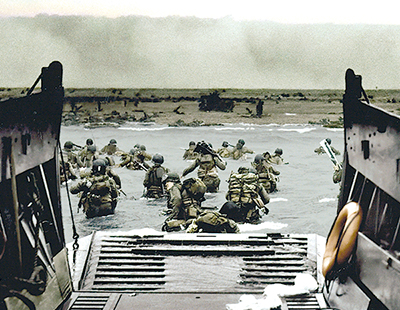D-Day story on 80th shared with local Disabled Vets

Highlights from Harper’s story follow:
Gen. Dwight D Eisenhower, Supreme Commander of the Allied Expeditionary Force, was blessed with resourceful logisticians who gave the combat forces everything they needed and much of what they wanted to accomplish the incredibly daunting invasion of France, code named Overlord but better known as D-Day.
Victory was achieved by young Allied soldiers who faced and defeated the enemy, but their success was made possible by the transporters, quartermasters, medics, engineers and others, many of whom also experienced the risks and hardships of combat.
More than 132,000 troops landed on June 6 with their equipment, vehicles, weapons and essential supplies. They crossed a shore littered with debris, mines and obstacles and were under fire from snipers, machine guns and artillery.
So how many is 132,000? I commanded a logistics unit in the redeployment phase of Desert Storm. Each morning I would be briefed on the number of supplies we were managing. After several days of hearing numbers, which meant nothing to me except that they were large, I asked the briefer to tell me something I could do with these supplies to help me visualize the amounts.
I don’t remember the numbers but I do remember that we had sufficient sandbags to build a wall three-feet high across the United States. The logistical challenge of D-Day was enormous and this article is intended to help you visualize the challenge and fully appreciate the accomplishment.
Landing 132,000 fully equipped soldiers is equivalent to moving the current population of Columbia, South Carolina, with all their vehicles, tools of trade and life support. It is also greater than the current population of 25 other state capitals. By June 30, more than 850,000 men, 148,000 vehicles and 570,000 tons of supplies had landed in Normandy.
To visualize 850,000 soldiers, consider putting them in standard passenger buses bumper to bumper. The line would stretch 137 miles, approximately the distance from Los Angeles to San Diego.
Arranged similarly, the 148,000 military vehicles would stretch 647 miles, or from New York City to Detroit, Michigan.
The Naval Operation, code named Neptune, consisted of more than 1,200 combat ships, more than 5,000 landing ships, plus ancillary craft and merchant ships. Combat ships ranged from battleships to destroyer escorts.
Each ship was a floating city, requiring large quantities of fuel and other supplies. The merchant fleet included 326 cargo ships. Anchoring just the cargo ships, bow to stern, would stretch 28 miles, longer than the width of the English Channel at its narrowest point.
More than 13,000 aircraft supported Overlord. 5,000 bombers and more than 4,000 fighters prepped the battlefield and provided close air support. 2,300 aircraft and 800 gliders delivered 18,000 paratroopers, crucially needed supplies and evacuated the wounded.
These aircraft also consumed significant quantities of fuel and ammunition as well as repair parts and teams of mechanics to keep them in the air. 13,000 is the number of aircraft in all branches of the US military today.
As usual, the number of troops in the logistical tail significantly outnumbered those in the combat teeth.
Other facts, statistics
Other facts and statistics about the Normandy Invasion, courtesy of Britannica.com:
After the 1940 evacuation at Dunkirk, the British focused on defending England against a cross-Channel invasion rather than launching one.
Operation Bolero was the buildup of American Forces in the United Kingdom, initially to support this defense.
By December 1942, the situation had sufficiently improved for the Allies to consider an offensive.
The Allies were fighting on many fronts, and each campaign competed for limited resources. Two proposed invasions, Sledgehammer in 1942 and Roundup in 1943, were both cancelled due to logistical shortages, specifically landing craft.
British Gen. Bernard Montgomery (later Field Marshal), commander of the Allied ground forces, argued that an invasion force of three ground and one airborne division was insufficient.
Eisenhower approved his recommendation; five ground divisions and two airborne
divisions landed on D-Day. This increase required more shipping, landing craft
and supplies as well as more logisticians.


